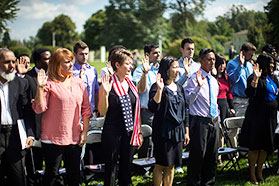
| Sept. 2014 | |||||||||||
| Top stories | |||||||||||
| In the news | |||||||||||
| Photos | |||||||||||
| Contact us | |||||||||||
| Archive | |||||||||||
|
New citizens get naturalized |
Birgit Schulze never intended to come to America. Having only lived in East Germany, Schulze’s fate changed after the fall of the Berlin Wall in 1989.

Birgit Schulz, clerk (second from the left), takes the oath to become a citizen of the United States of America.
The reunification of Germany allowed her to meet her future husband — an American citizen.
Schulze, an employee at the University of Iowa Hygienic Lab, said the process was easy with the support of her colleagues at the lab, as well as her friends.
Now divorced from the man she followed to Iowa, Schulze felt pure bliss after her naturalization on Wednesday.
She said she cannot wait to use her new rights as an American citizen, one of which she’ll be able to use this November.
“I will be very happy to go and vote soon,” Schulze said.
Schulze was one of 77 immigrants who took the oath of allegiance at a naturalization ceremony at the Herbert Hoover Presidential Library and Museum. The immigrants are now former citizens of 31 countries and six continents, and the new citizens range in age from 20 to 68.
As part of the 227th anniversary of the signing of the U.S. Constitution, more than 27,000 people will be naturalized this week, according to U.S. Citizenship and Immigration Services.
Chief Magistrate Judge Jon Scoles of the of the U.S. District Court for the Northern District of Iowa said that days such as Wednesday are his favorite as a judge.
“Almost everything I do relates to conflict,” he said. “But this is one of those rare days where there is none, everyone is excited, everyone is happy.”
He said during his remarks at the ceremony that the event taking place on Constitution Day makes the event even more special. Sept. 17 marked the 227th anniversary of the signing of the constitution.
“The Constitution is the foundation, and having new citizens welcomed on this day makes it doubly special,” Scoles said.
Every naturalized citizen must go through a process by U.S. Immigration and Citizenship Services that can take anywhere from three to five years, depending on how immigrants traveled to the United States, said Marc Dillon, an officer with the citizenship and immigration service.
Dillon said this year the number of naturalized citizens at the Hoover ceremony has risen from around 70 at the last ceremony to this year’s 77.
He also said that there are a few common snags for some people looking to become citizens, and although most people in the process do make it through, it can lengthen the process for some.
“Normally, people have trouble passing the interview, the English reading and writing on the naturalization test,” he said.
According to a press release in June, the passing rate for the citizenship test is 91 percent.
The test requires them to read and write in English as well as have knowledge of U.S. history and government.
Representatives of the Iowa congressional delegation read letters on behalf of Sen. Chuck Grassley, Sen. Tom Harkin, Rep. Bruce Braley, and Rep. Dave Loebsack.
The new naturalized citizens also heard a recorded message welcoming them as citizens from President Obama, who noted that Americans were a melting pot connected by common ideals.
One of the naturalized citizens, Elshahir Abdalla, originally from Sudan, said the history aspect is exciting to him.
Abdalla is attending community college, where he one day dreams of attaining a Ph.D. in political science and “becoming an icon.”
“Coming from a poor country of Sudan, to come here to the first country in the world is so great,” he said.